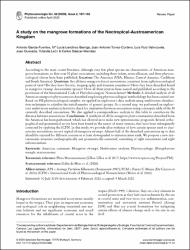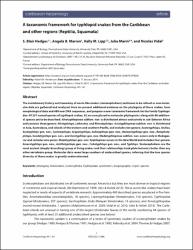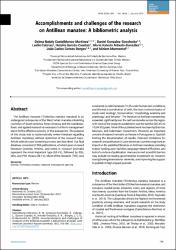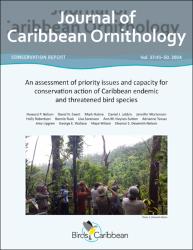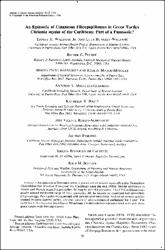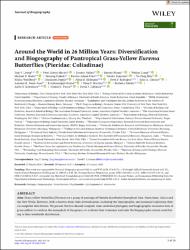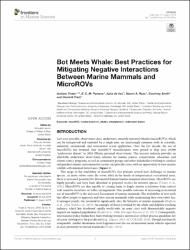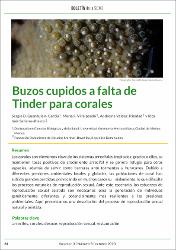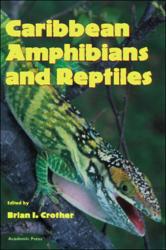Browsing Investigación ambiental by Subject "Biodiversidad"
Now showing items 1-20 of 141
-
A guide to Caribbean vegetation types : preliminary classification system and descriptions
(1999)Improved conservation of the distinct natural vegetation types that occur on Caribbean islands is greatly facilitated if these vegetation types are accurately understood, described, and mapped in a manner that is accepted ... -
A study on the mangrove formations of the Neotropical-Austroamerican Kingdom
(2020)According to the most recent literature, although very few plant species are characteristic of American mangrove formations, to date over 30 plant associations, including three orders, seven alliances, and three phytosociological ... -
A taxonomic framework for typhlopid snakes from the Caribbean and other regions (Reptilia, Squamata)
(2014)The evolutionary history and taxonomy of worm-like snakes (scolecophidians) continues to be refined as new molecular data are gathered and analyzed. Here we present additional evidence on the phylogeny of these snakes, ... -
Accomplishments and challenges of the research on Antillean manatee : A bibliometric analysis
(2023)The Antillean manatee (Trichechus manatus manatus) is an endangered subspecies of the West Indian manatee inhabiting countries of South America, Meso America and the Caribbean. Basic and applied research is necessary to ... -
American Crocodile Crocodylus acutus
(2010)The American crocodile is the most widely distributed of the New World crocodiles, ranging from the southern tip of Florida, along both the Atlantic and Pacific coasts of southern Mexico, Central America, and northern South ... -
An assessment of priority issues and capacity for conservation action of Caribbean endemic and threatened bird species
(2024)Abstract: Despite decades of conservation effort, Caribbean endemic and threatened bird species continue to decline and many are Critically Endangered. In 2022, the BirdsCaribbean Endemic and Threatened Species Working ... -
An atlas of sea turtle nesting habitat for the Wider Caribbean Region
(2007)The fundamental need to identify habitat necessary for the survival of the region’s sea turtles has long been recognized, yet the coastal zone remains one of the least protected environments in the region and unchecked ... -
An epizootic of cutaneous fibropapillomas in green turtles Chelonia mydas of the Caribbean : part of a panzootic?
(1994)An epizootic of fibropapillomas in green turtles Chelonia mydas (Reptilia: Testudines: Cheloniidae) has occurred throughout the Caribbean since the mid-1980s. Similar epizootics in Hawaii and Florida began 5 years earlier. ... -
An extinct monkey from Haiti and the origins of the Greater Antillean primates
(2011)A new extinct Late Quaternary platyrrhine from Haiti, Insulacebus toussaintiana, is described here from the most complete Caribbean subfossil primate dentition yet recorded, demonstrating the likely coexistence of two ... -
An overview of the evolution and conservation of West Indian amphibians and reptiles
(2006)The total area of the West Indies is small, only 0.15% of Earth’s land area, but the region supports 3.0% (180 species) of the world’s amphibians and 6.3% (520 species) of the world’s known reptiles. Nearly all species are ... -
Araneofauna (Arachnida: Araneae) de la sabana de pajón en el Parque Nacional Valle Nuevo, República Dominicana y su comparación entre dos temporadas del año
(2014)[Español] Se registran y comparan la riqueza, diversidad y abundancia de las arañas asociadas a la sabana de pajón dentro del Parque Nacional Valle Nuevo entre una temporada lluviosa y una seca. -
Around the world in 26 million years : diversification and biogeography of pantropical Grass-yellow Eurema butterflies (Pieridae: Coliadinae)
(2025)Aim: Grass-yellow butterflies (Eurema) are a group of pantropical Pieridae distributed throughout Asia, Australasia, Africa and the New World. However, little is known about their diversification, including the biogeographic ... -
Assessing Magnoliaceae through time : major global efforts to track extinction risk status and ex situ conservation
(2023)Comprehensive Red List assessments act as valuable resources for informing protected area designations, national protected species legislation and action strategies, and international biodiversity agreements, yet they are ... -
Assisted sexual coral recruits show high thermal tolerance to the 2023 Caribbean mass bleaching event
(2024)Assisted sexual coral propagation, resulting in greater genet diversity via genetic recombination, has been hypothesized to lead to more adaptable and, hence, resilient restored populations compared to more common clonal ... -
Biodiversity - Handbook of the Anthropocene in Latin America II
(2024)Biodiversity should not be understood in biological terms only and as a thing apart from society, but rather as biocultural diversity present in the social world and in various cultures. Such a perspective might allow to ... -
Birds of the world
(2025)[English] Birds of the World is a fully collaborative ornithological platform that brings together deep, scholarly content from several celebrated works of ornithology with millions of bird observations from eBird and ... -
Bot meets whale: best practices for mitigating negative interactions between marine mammals and microROVs
(2019)To better understand the potential risks and to establish an anticipatory framework to minimize negative interactions between MicroROV operators and marine mammals, we, a group of six experts in microROVs and/or marine ... -
Buzos cupidos a falta de Tinder para corales
(2023)Se presenta una descripción del proceso de reproducción sexual, natural y asistida de corales. -
El cambio climático y sus efectos en la biodiversidad en América Latina
(2015)América Latina y el Caribe es una región particularmente vulnerable a las amenazas del cambio climático. Esto, entre otras razones, por la riqueza en biodiversidad y por los endemismos que alberga. El presente documento ... -
Caribbean amphibians and reptiles
(1999)[English] Amphibians and reptiles are the most numerous, diverse, and frequently encountered animals on the Caribbean islands. This book provides a variety of perspectives on this amazing group of organisms. Caribbean ...


